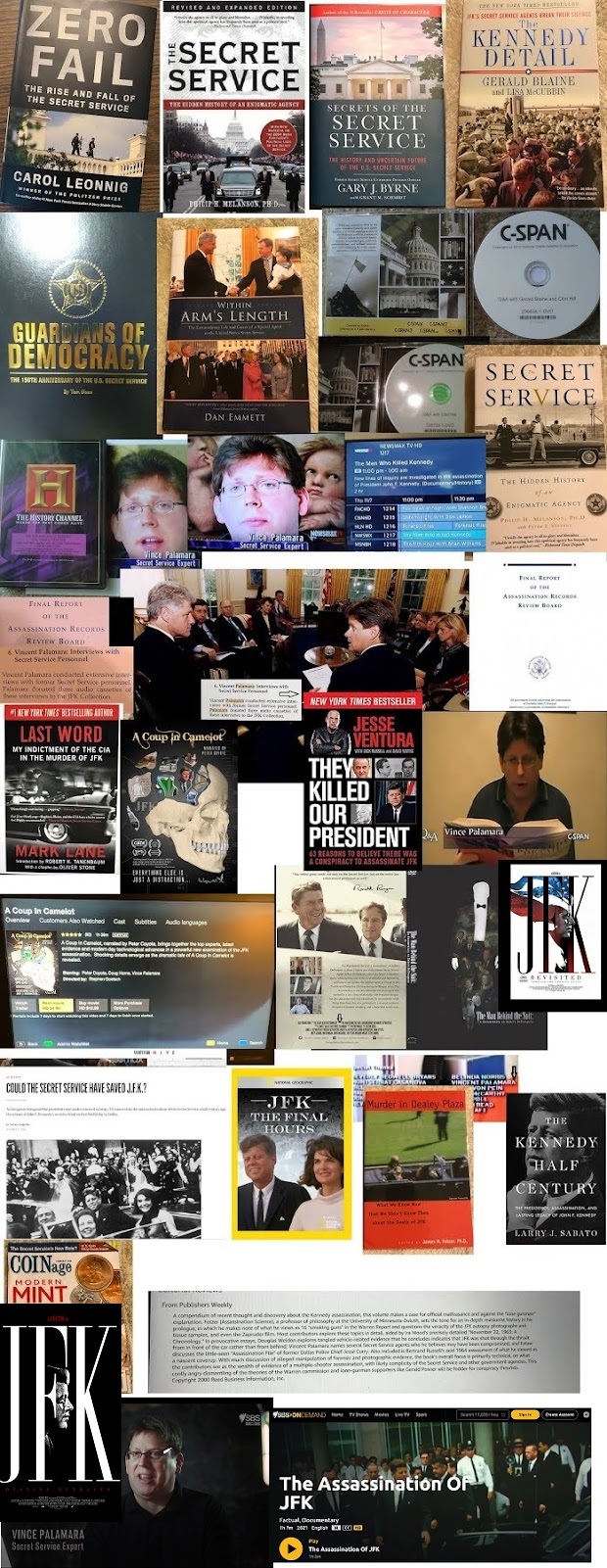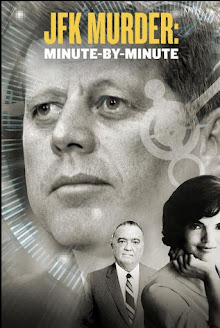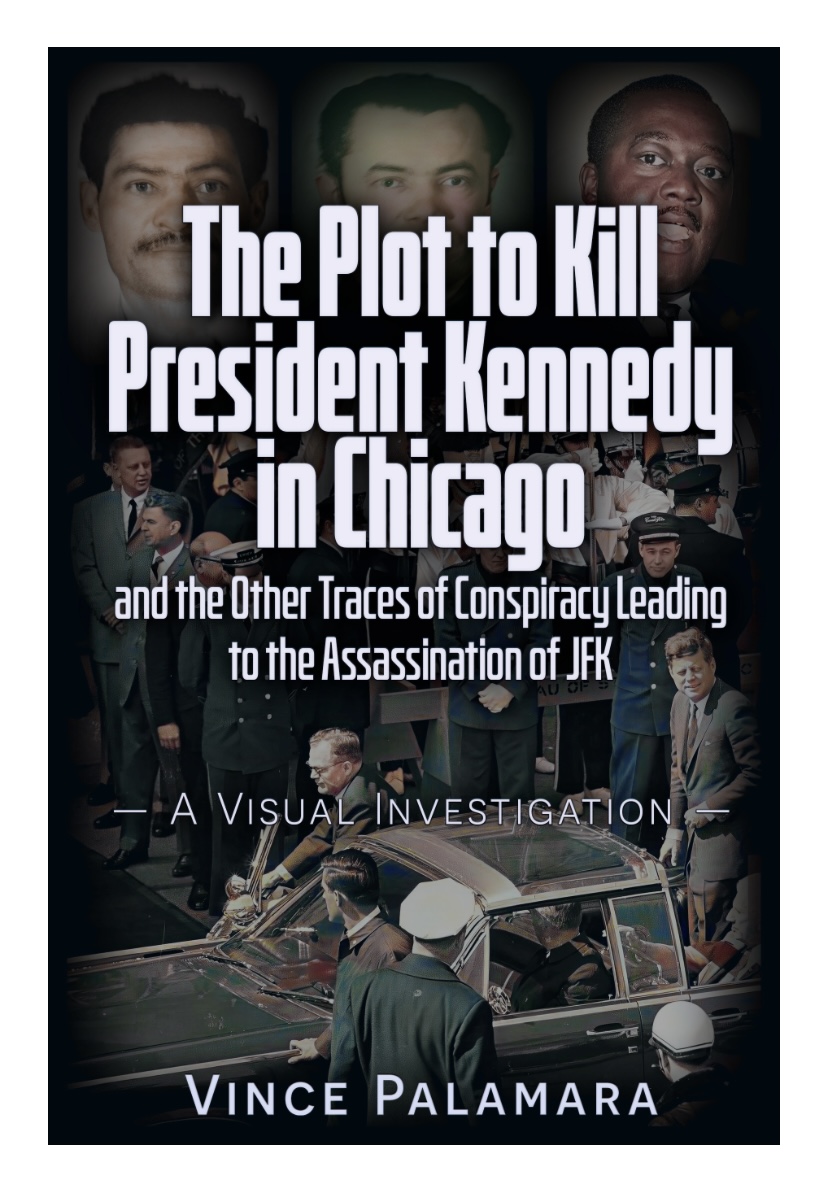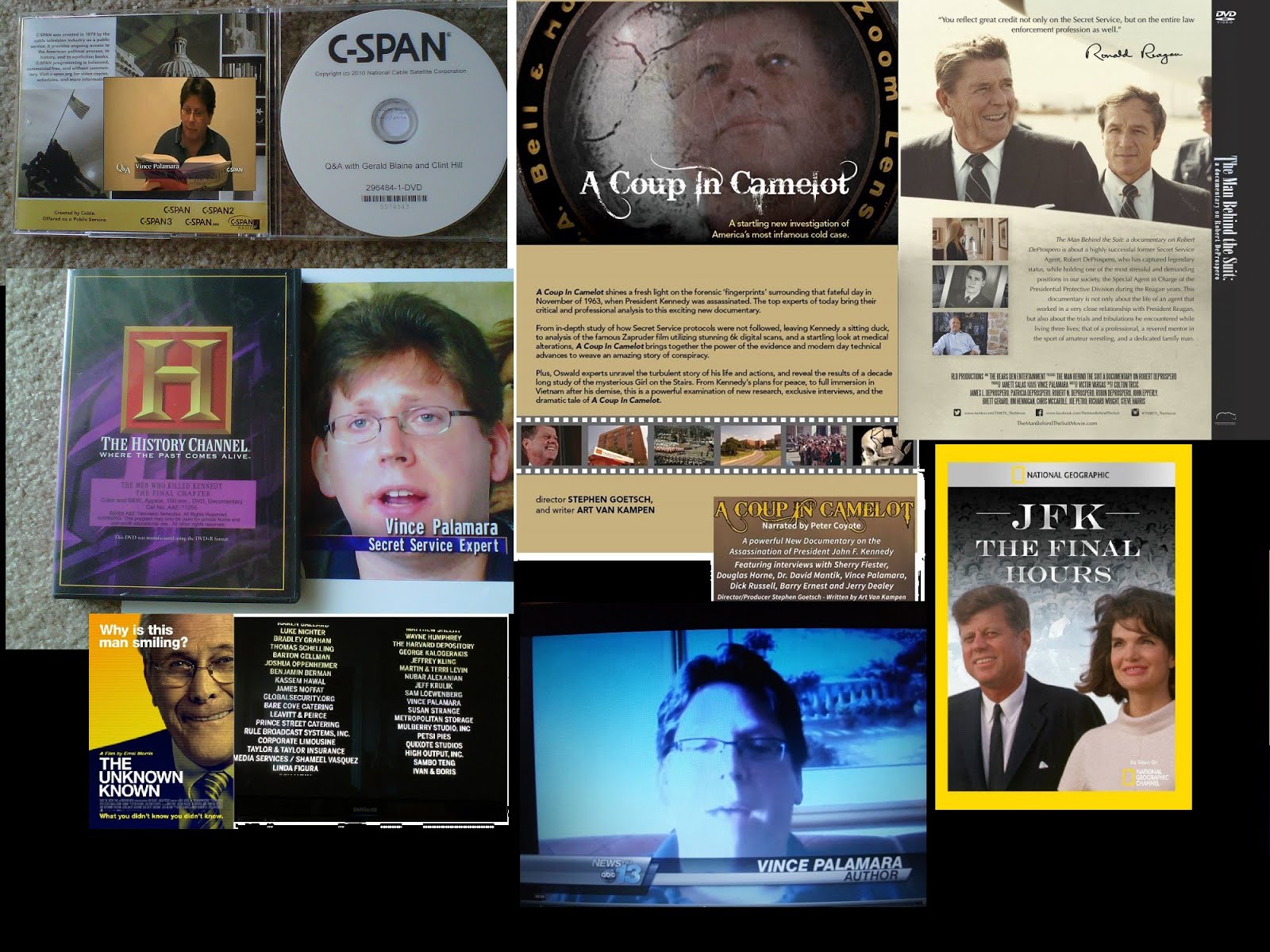Possible Secret Service Propaganda
by Vince Palamara|
Over the years, with the assistance of several well-placed Secret Service agents,
many documents and many books have been written that, on the face of it, have a certain
ring of authority --- until one looks a little closer at their claims, as this author has done in regard to the follow-ing items. Perhaps many will be familiar to
JFK researchers.
In Commission Exhibit 993 (18H642) ,which is a translation done by Secret Service
agent Leon Gopadze of a Marina Oswald letter, it is stated: "I am very, very grateful
to the Secret Service agents who treated me so well and took such good care of
me. Although some of the letters which I received accused these wonderful people of
preventing me from seeing others, I am free to do anything I want..." Give me a break! The New York Times of December 8, 1963 reported that "Secret Service agents suggested to her [Marina] that it might be safer and easier for her to return to the Soviet Union than to try to live in the United States. This distressed her...She is now secluded from Oswald's relatives as well as from the public." [emphasis added] Author Michael Dorman, in "Secret Service Story" (New York: Dell, 1975), dedicated his book "...to all the present and former members of the U.S. Secret Service, with particular appreciation to retired agent Lane Bertram, who took the trouble to show a young reporter the ropes in days gone by" (p.4). This Oswald-did-it book stands out for its sickeningly sweet approach to the Secret Service's ultimate failure, evidenced in many of its pages and perhaps summed up here best: "In the confusion, one group of men acted with a dispatch and precision born of hours of drill, discipline and professional training. These men were the agents of the United States Secret Service... Within an instant of the time the shots were fired, agents leaped into action. Pistols and automatic rifles appeared in their hands. An agent in the president's limousine immediately grabbed a radio-telephone. 'Let's go straight to the nearest hospital', he shouted to nearby policemen." (!?!) In agent Rufus Youngblood's Twenty years in the Secret Service - My Life with Five Presidents (New York: Simon & Shuster, 1973) he writes: "Particularly caustic and unfair were the criticisms heaped upon the two Secret Service agents in the President's car, Bill Greer and Roy Kellerman, apparently for not having pulled some miracle out of a hat to save the President." (p. 176) If hitting the gas pedal, obeying orders and cover-ing the President's body are miracles, the agency must have been blessed with many prominent religious figures ever since! Youngblood admitted to me that the book was largely ghost-written, but said he did play a large role in its genesis, as far as actual content was concerned. While writing Case Closed, Gerald Posner contacted Agent Floyd M. Boring, who in turn, put him in touch with Percy Hamilton Brown, the Executive Secretary of the Former Agents of the Secret Service. These are the only Secret Service sources known to be used by Posner -- although Brown is credited on page 503, it was only through my own interview with Boring that I learned of his contact with Posner; no other agents are credited anywhere in the entire text or footnotes of the book. From Case Closed, page 210: " [Forrest] Sorrels recommended the Trade Mart be selected for the luncheon". In fact, Sorrels did no such thing -- he told SAIC Jerry Behn that the Women's Building was a better site, security-wise. In any event, he was acting on orders emanating from Washington -- specifically, the office of both Behn and Floyd Boring. (See HSCA XI, pp. 504-521 and agent Winston Lawson's testimony to the Warren Commission in 4H 337) Posner says on page 220 "There was no change in the motorcade route, and there was no doubt about the Elm Street crossing". Again, Posner is dead wrong on both counts. Through my interviews with agents Jerry Behn and Sam Kinney, I learned that, indeed, the motorcade route was changed and that there were alternate routes (even agent Lawson told the Commission of alternate routes). Continuing on page 223, Posner says "As the president and his staff had requested, the plastic bubbletop was off, leaving the car as an open convertible, and no Secret Service men rode on the running boards attached to the rear. The motorcycle escort was limited to four, and kept at a comfortable distance from the limousine." Now -- it's time for the truth: Agent Sam Kinney himself admitted to me that it was his sole responsibility for the removal of the bubbletop -- a decision he has lived with, with some regret for over thirty years now. Richard Greer, son of the late Bill Greer, told me of his father's guilt over this decision of the Secret Service. Three agents -- Sam Kinney, Bob Lilly and Thomas Kelley -- stated that the bubbletop, although not bulletproof, may have at least deflected a bullet or, at the very least, somewhat hampered a gunman's view via the sun's glare off its surface. Significantly, agents Behn, Boring, Kinney, Bouck, Lilly, Abraham Bolden, John Norris, Maurice Martineau and Rufus Youngblood ALL told this author -- in no uncertain terms -- that Kennedy never restricted the agents from doing anything, nor interfered with their actions at all. The only thing that would concern agents was JFK's proclivity to wade into crowds to shake hands with well-wishers, but there were never any orders from him to have the men removed from the running boards of the limo or to do anything else regarding security. Agent Kinney also told me that presidential assistant Ken O'Donnell did not interfere with these matters either. As Secret service Chief Rowley told the Commission, "No president will tell the Secret Service what they can or cannot do." (5H470) To put it simply: these were, without a doubt, Secret Service decisions! (for further details, seeThe Third Alternative by this author) In keeping with the above, it was also the Secret Service decision to limit JFK to just four non-flanking motorcycles, as opposed to the eighteen flanking motorcycles he received during the three previous stops in Texas on November 21 and 22, a matter that the House Select Committee labeled "uniquely insecure". Agent Sam Kinney was quite adamant during our interview on this issue -- that Kennedy did not make any requests involving placements of motorcycle policemen in his motorcades. Posner's at it again on page 234: "The Secret Service agents were slow to react, although some had turned to look at the source of the noise, the Book Depository... Incredibly, Greer, sensing something was wrong in the back of the car, slowed the vehicle to almost a standstill and turned in his seat to see what had happened. [Clint] Hill... responded rapidly... at that moment, Greer slammed on the accelerator..." Once again, there is much to dissect here: 1) Agent Paul Landis wrote in both of his reports in Volume XVIII of the Hearings and Exhibits, that the shots came from the front, and, as Altgens photo #5 makes quite clear, only agents Ready and Hickey appeared to be looking to the rear (and at the Depository, perhaps). Agents Roberts, Kinney and Clint Hill appear to be looking directly at the President! In the Zapruder film, we can see both Greer and Kellerman look back at JFK; in fact, Greer turns around twice to look at Kennedy -- a crucial matter which he denied , among other things, in his Commission testimony. 2) Clint Hill actually did not respond as rapidly as has been assumed--- the limousine was only going at approximately 11.2 miles per hour, and the distance between the two cars was only about five feet. Since he appears to be looking directly at JFK in the films and photographs of the onset of the gunfire, he seems to have had plenty of time to mount the limousine before he actually did (not to mention what actually being posted there would have done to Hill's -- and agent Ready's -- reaction times!) A few other Posner items worthy of mention in this context: Like author William Manchester before him, Posner believes the "agent" who spoke to Oswald in front of the Book Depository (p.245) was NBC reporter Robert MacNeil --- a matter hotly disputed by many, including this author, William Weston, reporter Pierce Allman and, to a certain extent, MacNeil himself. And on page 299: "Certainly, the President would have been taken to Parkland (the hospital listed as the primary stop in case of emergency)..." I would love to know where Posner got that one from! Agents Greer, Lawson and Rowley made it clear to the Warren Commission that this was not so: a) Incredibly, the Secret Service did not then follow the now current procedure of having hospitals on alert status -- the situation literally developed "on the spot." b) Greer stated that there was no radio communication between the limousine and Parkland Hospital --as evidenced by the fact that there were no waiting attendants or stretchers at the ready. c) Lawson made no mention of this when asked by the Commission -- although he did, strangely enough, equivocate about his knowing whether Parkland was the closest hospital, which, I believe, it was not; Methodist Hospital was nearer. Posner says that agent Glen Bennett was "mistaken" when he wrote in his "contemporaneous" notes that "the President [was hit] about four inches down from the right shoulder." Although Bennett's ability to have actually seen this is a very strong point, which is not made by Posner -- we know that the death certificate, the body chart, the available autopsy photographs, the President's jacket and shirt, and the testimony of Greer, Kellerman, and Hill all place the wound about four to six inches down on the back -- not the neck. On page 324, Posner states, "None of the witnesses recall the sound of a bullet striking metal." Wrong again: Clint Hill did! (2H 144) Could this have been, perhaps, a strike on the chrome frame around the windshield of the limo, or even the Stemmons sign? The-Oswald-as FBI Informant Story is attributed by Posner to Dallas Assistant D.A. Bill Alexander, who, along with two reporters (including Lonnie Hudkins) "printed the story, attributing it to an unidentified source." (p. 348) Actually, that 'source' appears to have been Agent Lane Bertram, the SAIC of the Houston office of the Secret Service. (See The Third Alternative, p. 57, by this author.) Right wing activist Joseph Milteer's well-documented and accurate prediction about the impending assassination of JFK is written off in Case Closed as a "boastful claim," but the truth is that this was a matter that the Secret Service was very much aware of before November 22, 1963 . There are numerous sources on this, including 1994 press stories and Agent Robert Bouck's confirmation of the story to me. What do you think? Secret Service propaganda? |










































![VINCE PALAMARA [remember to scroll all the way down!]](https://blogger.googleusercontent.com/img/b/R29vZ2xl/AVvXsEjSZ-Z_puqnjl3UgdiJxBenMyIMaFhmBD-PYQUsxCtFS4UF7dJQB6n32rt9a0ZqFRPmuBoukhrMZxv6LOD9GoUGPiaShO3wj_8xL98obRAsUbIf0mXutzbq7jKDrCp8Y-Y0k9rnS5ARjQQ/s1600/11.jpg)


![CHAPTER 8 OF ARRB FINAL REPORT [I AM IN THIS REPORT, AS WELL]...HMMM---THE SECRET SERVICE DESTROYS](https://blogger.googleusercontent.com/img/b/R29vZ2xl/AVvXsEimGbOuG69gW-cgAbsfjd8p8PD-subznIjcsQXUSFq560o_kiXunf9TcH0fkOqmWuK73id6m5TyVMhWcfBrPUEee6JLbvqNZKdIVQa5Drcz568Ue6GZdf_PUtLuLwPDcucv3gOn5KGBZPw/s1600/DSCF0462.JPG)




No comments:
Post a Comment